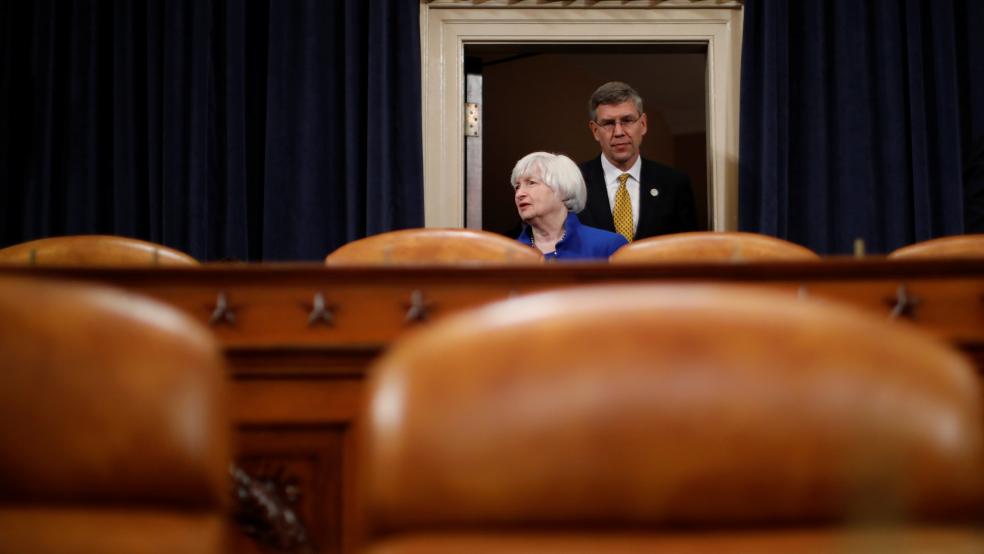Like once-spurned lovers given a second chance, the bulls on Wall Street are again reveling in the warm embrace of Federal Reserve Chair Janet Yellen. As a result, the Dow Jones Industrial Average has broken back into positive territory for the year and is racing back toward a level of multi-year resistance near 18,000. Spirits are high. All seems to be right in the world again, or at least a whole lot better than it was just five weeks ago.
Yellen and the Fed delivered a "dovish hold" on Wednesday. Not only were interest rates left unchanged, but the Fed halved its rate hike forecast for the rest of the year to just two quarter-point moves — bringing its outlook closer into alignment with where the futures market is (while apparently ignoring recent evidence that inflation is firming).
Related: Nearly $1 Billion in Unclaimed Tax Refunds Up for Grabs — Until April
The dovishness follows months of volatility and uncertainty for investors, amid a nagging fear that maybe, just maybe, the Fed was walking back years of goodwill on Wall Street. December's rate hike, the first since 2006, was an ice pick to the heart made all the more painful by a forecast for four further hikes in 2016.
But now, we're seeing an apparent return to status quo ante. Unfortunately, as I'll explain below, the dynamics of the relationship have changed. There are downsides to what the Fed has done.
Mainly, the worry is that policymakers are about to fall behind the curve on inflation as core prices are picking up and the labor market continues to tightening. That seems to be the verdict from the currency and commodities markets, with the dollar plunging and gold and silver soaring — a loud warning that the Fed is trading the specter of higher inflation for immediate relief from stock market instability.
For the precious metals, this looks to be the end of the long downtrend that started in 2011.
Should inflation continue to heat up, the Fed will not be able to simply back away from further rate hikes whenever the stock market gets bumpy without risking its credibility. But at that point, investors will be even more dependent on Yellen's monetary morphine. The withdrawal has only been made more painful.
Core consumer price inflation increased at a higher-than-expected 0.3 percent monthly rate in February, pushing the annual rate to 2.3 percent, the highest since May 2012. Economic data has been coming in stronger as well, with single-family housing starts increasing to their highest level since late 2007.
Related: Here’s Why China’s Not the Global Economy’s Problem
The missing ingredient has been robust wage gains, something Yellen said in her post-announcement press conference that she still expected to see.
JPMorgan economist Michael Feroli is looking for two rate hikes this year at the July and December meetings. If so, this would be slightly ahead of market expectations, a possible source of disappointment. But even this could be a best-case scenario for traders, as Feroli notes that "recent solid employment and inflation data may argue for a hike earlier than July."
The team at Capital Economics is looking for a June hike followed by an acceleration in inflation that will "force the Fed to raise rates much faster than is widely appreciated." This outlook, predicated on hard economic data, could be enough to push stocks away from current levels and result in a retest of recent lows.
Related: The Brutal Economic Truth Behind the Rise of Trump
How high could interest rates go if inflation does pick up? Steve Murphy at Capital Economics is looking for the Fed funds rate to be at 1.25 percent by year-end 2016 and as high as 2.5 percent by year-end 2017.
Let's not forget the other consequence of the post-Fed weakness in the U.S. dollar: Higher crude oil prices, which will not only put upward pressure on inflation measures but pinch consumer pocketbooks as well. On Thursday, crude oil gained 4.2 percent to close at $40.07 a barrel, returning to levels not seen since early December.
Anthony Mirhaydari is founder of the Edge and Edge Pro investment advisory newsletters. Two-week and four-week free trial offers have been extended to Fiscal Times readers.






